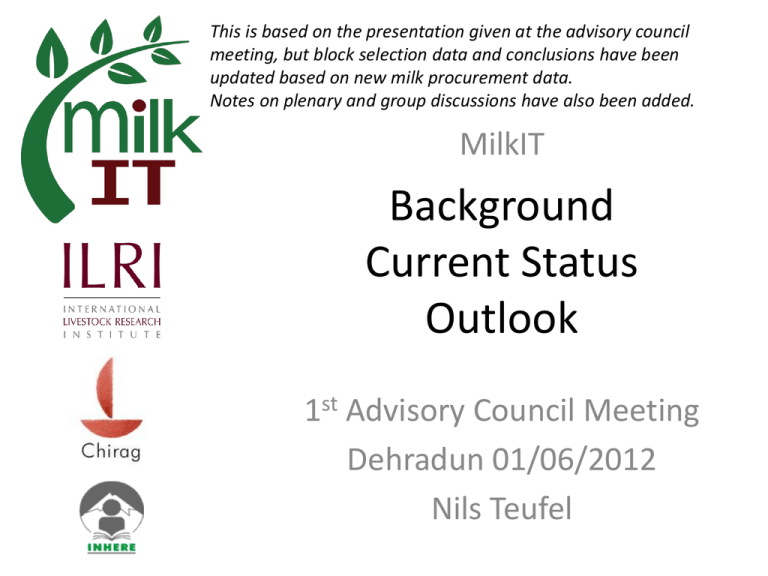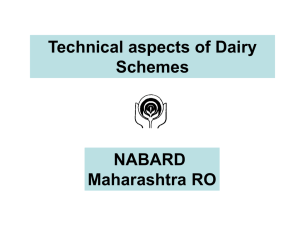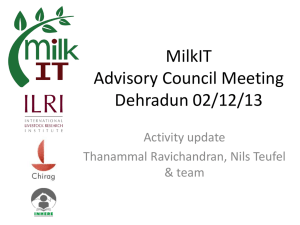Background Current Status Outlook
advertisement

This is based on the presentation given at the advisory council meeting, but block selection data and conclusions have been updated based on new milk procurement data. Notes on plenary and group discussions have also been added. MilkIT Background Current Status Outlook 1st Advisory Council Meeting Dehradun 01/06/2012 Nils Teufel Topics • Background – ILRI’s activities in South Asia – History of the MilkIT proposal – Major structure • Current status – – – – Collaboration with Ajeeveeka/IFAD Selection of sites & partners Detailed work-plans Preparations for implementation • Outlook – Next activities in 2012 – Plans for 2013 01/06/2012 2/35 Background – ILRI in South Asia • Feed improvements (fodder, food-feed crops, processing) • Market development • Work on innovation 01/06/2012 3/35 Background – History of MilkIT • Fodder Innovation Project/ Fodder Adoption Project • OPEC dairy feeding & marketing project • EU/IFAD call 01/06/2012 4/35 Background – major structure • Institutional strengthening – Value chain assessments – Stakeholder involvement – Innovation platforms for improved dairy marketing • Productivity improvements – Feed assessments – Technology matching – Innovation platforms for productivity improvements focussing on feeding • Knowledge sharing – Communication outputs – Meetings between partners, stakeholders, countries 01/06/2012 5/35 Status – Collaboration Ajeeveeka • IFAD aim of linking loan programmes to grants • Building on base laid by ULIPH • Alignment with development of ILSP – Site selection – M&E framework (base-line survey) – Support for value chain activities • Comparison with Tanzania 01/06/2012 6/35 Status – Site selection, districts Districts IFAD HARKIDUN PUROLA 0 CHHOLMI GANGOTRI UTTARKASHI JADAR IFAD_ILSP BHATWARI PUROLA TIUNA HATAR RAJGARHI BHATWARI RAJGARHI CHAKRATA BADRINATH " DUNDA CHAURANGI KHAL CHAKRATA DUNDA JOSHIMATH BHARKOT OKHIMATH PRATAPNAGAR JOSHIMATH RUDRAPRAYAGOKHIMATH TEHRI PRATAPNAGAR GHANSYALI BHATWARI CHAMOLI TEHRI GARHWAL TILWARA " DEHRA DUN POKHRI " DEVAPRAYAG CHAMOLI MUNSYARI KARNAPRAYAG " DEHRA DUN CHAMOLI " VIKASNAGAR SRINAGAR PHURKIYA NARENDRANAGARDEVAPRAYAG " RISHIKESH PAURI KARNAPRAYAG THARALI PITHORAGARH THALISAIN BAGESHWAR " BAIJRO LAKSAR KAPKOT BAGESHWAR LANSDOWNE KOTDWARA RANIKHET DHUMAKOT BHIKIYASAIN ALMORA DHARCHULA " ROORKEEROORKEEHARIDWAR GARHWAL HARIDWAR LANSDOWNE DHARCHULA MUNSYARI DIDIHAT DIDIHAT GANGOLIHAT RANIKHET PITHORAGARH " " ALMORA NAINI TAL NAINI TAL CHAMPAWAT " " RAMNAGAR KASHIPUR CHAMPAWAT HALDWANI KASHIPUR HALDWANI • Ajeeveeka activity • Either Kumaon or Garhwal • Mid-hills • Dairy dynamics UDHAM SINGH NAGAR " KICHHA SITARGANJ KHATIMA SITARGANJ KHATIMA 01/06/2012 7/35 Status – Partners 1 • Which type of partners (December workshop)? HIMMOTHAN IFAD INHERE LCM (Loke chetna manch) CHIRAG CHEA 01/06/2012 8/20 Status – Partners 2 • Medium NGO with – local experience and – capacity for research – INHERE in Almora • Would new federations be a more sustainable structure? – Bageshwar – Chamoli? – Perhaps not yet – CHIRAG in Bageshwar 01/06/2012 9/20 Status, block selection - ILSP Partner activities 01/06/2012 10/35 Status, block selection, market access Milk procurement Aanchal 2011/12 [kg/bov fem] Village road access % 90 80 70 60 50 40 30 20 10 0 25.0 20.0 15.0 10.0 5.0 0.0 01/06/2012 11/35 Status, block selection, land use ShareForestOfUtilized ShareIrrArea %NetSown 60% 30% 50% 25% 40% 20% 30% 15% 20% 10% 10% 5% 0% 0% 01/06/2012 12/35 Status, block selection, bovine density BovFem/km2 250 200 150 100 50 0 01/06/2012 BovFem/cap 0.90 0.80 0.70 0.60 0.50 0.40 0.30 0.20 0.10 0.00 13/35 Status, block selection, intensified livestock BuffFem/BovFem % 45 CbFem/BovFem % 3.0 40 35 2.5 30 2.0 25 20 1.5 15 1.0 10 5 0.5 0 0.0 01/06/2012 14/35 Status, block selection, conclusion • Bageshwar – Chirag only active in Bageshwar block – Dairy development indicators (milk procurement, forest share) also support Bageshwar block • Almora – Chaukutia excluded: high forest & irrigation – Syaldeh excluded: low milk procurement – Bhikyasen and Sult both possible – more data required 01/06/2012 15/35 Status, site selection, clusters • Bageshwar block – Chirag is active in two clusters – Kathpuryachina – Dewaldar • Bhikyasen & Sult – Inhere has links to both blocks – Cluster overviews for Bhikyasen & Sult 01/06/2012 16/35 Status, site selection, sub-clusters • Village census at cluster level • Classification of sub-clusters by milk marketing (formal/informal) • Defined by field facilitator reach (4-6 villages) • Base for feed innovation platform? • Dairy innovation platform at cluster level? • Control sites within cluster? 01/06/2012 17/35 Preparations for implementation • • • • • • Office Secondary data collection Local contacts Detailed work-plans Partner agreements Value chain assessment tools 01/06/2012 18/35 Outlook – activities 2012 (work plan) Steps Topics Tools Time Site selection Block data for cluster Secondary data June Cluster data for sub-cluster Village census June Village survey July Value chains VCA September Development Actor mapping August Feeding & feed gaps FEAST October Characterisation Villages Innovation 01/06/2012 Dairy market platform formed October Feeding platform formed November Market interventions identified December Feed interventions identified January ‘13 19/35 Outlook – activities 2013 Steps Topics Innovation Intervention trials round 1 Jan-Apr Intervention trials round 2 May-Aug Scaling-up of interventions Jul-Oct Platform sustainability Sep-Nov Moving on Time Documentation Reports Sep-Nov Publicity Workshops Demonstrations Media Sep-Nov Impact assessment 01/06/2012 Tools Oct-Nov 20/35 Thank You! 01/06/2012 21/35 Discussion on presentation - 1 • What is the meaning of “innovation platform”? – – – – It’s about to bringing together experiences of a variety of stakeholders on dairy marketing, feed support , knowledge sharing and innovation/change regarding how to test & adapt these innovations. Innovation platforms are not only a discussion forum and not just an extension activity. • What will be the project output in Dec 2013 and who will receive it? – As a research project, papers and reports will be major outputs, with IFAD being the first recipient. – Research outputs will be aligned with the demands of donors and partners. – Documentation of processes and results will enable global and local use. – Documentation of establishment and success/failure of innovation platforms will be a major output. Induced changes will be a main indicator. • What will be language of dissemination? – Main audience will be institutions. Therefore, first language will be English. – However, for local institutions documents in Hindi will also be prepared. 01/06/2012 22/35 Discussion on presentation - 2 • What will be done to reduce livestock impact on forests? – Feed requirements, current sources & opportunities will be assessed with FEAST – General land-use change will not be a focus of MilkIT because of its short duration – More efficient use of existing resources will probably emphasise farm products and labour efficiency (reducing forest use) – Himmothan has already experience with introducing winter fodder. Forest use has already decreased. • How can MilkIT improve green fodder supply when the project is only 20 months and most green fodder comes from trees which yield only after 3-5years? – MilkIT will prioritise technologies (with the help of Techfit) which yield fast effects (no planting campaigns, no focus on breed improvement). – More efficient use of existing feeds will be focus (supplementation, chopping) and wider use of under-utilised resources (grass-lands). 01/06/2012 23/35 Discussion on presentation - 3 • How will feed-related problems be identified? How will local capacity & willingness for adoption be considered? – Innovation platforms will improve communication. – Specific tools (e.g. Techfit) will enable efficient discussion. • What will be main project indicators, milk yield? – Milk yield will be important, but profitability and labour returns will also be main indicators. – Improved productivity will decrease pressure on forests. • How will other aspects of productivity be considered (breed, health) and who will be doing this? – Within the project period no major breed improvement effects can be expected. – But we know that local cows are being replaced with buffaloes. – Feed improvements offer greater effect in improved animals with less labour. – Where health issues are important we include local institutions in platform. 01/06/2012 24/35 Discussion on presentation - 4 • How will the variation between households and animals be considered? – MilkIT will only target groups (e.g. SHGs), not individual households/animals – At the platform level discussions will have to consider for which type of households/animals technologies are suitable. – When documenting effects we will have to collect household/animal data. • How is MilkIT going to compete with strong local dairy organisations? – We will map which institutions are working on which issues. – The innovation platforms will bring all relevant and willing actors together as a complementary activity. – We are aware that compared to local institutions MilkIT will only show a brief appearance and cannot compete. 01/06/2012 25/35 Group discussions 1. Innovation platforms: – – “How can innovation platforms support development and dissemination of new technologies for dairy development?” Himmothan, GBPIHED, Elks, AHD 2. Marketing constraints: – “What are you most interested in for overcoming institutional and marketing constraints in the dairy sector?” – Aanchal, Ajeeveeka, ULDB, Chirag 3. Feeding constraints: – “What should MilkIT produce to help with improving productivity of dairy animals among small holders through better feeding, breeding & health?” – GBPUAT, FD, VPKAS 01/06/2012 26/35 Grp 1: Innovation platforms M. Chauhan R.S. Negi 01/06/2012 R.S. Rawat S. Jarial R.C. Rajaguru 27/35 Grp1 Innovation platforms • Value of innovation platforms Most important – Contribute by bringing in technologies, pilot them, scale it up – By creating platform at different levels, knowledge sharing at right levels – By creating awareness, demonstration wider audience, feedback, knowledge documentation – Difficulties & risk: – Sustainability, ownership, scope – Compendium of successful experiences – Malavika: Ownership for sustainability (who owns) – Negi: What about the costs for maintaining platform – Malavika: which scale? block level officers/ paravets/ ext. workers don’t talk to each other, maybe that would be useful – NGOs do talk to each other – Padma: what is the actual income contribution of milk, what can actually be improved through more milk 01/06/2012 28/35 Additional input on innovation platforms (later) • Padma: expand the innovation platforms to include other actors who work in different fields (e.g. breeding, health, small ruminants etc.). Offer the platform as a useful and efficient approach to get collaboration & knowledge exchange going. • Malavika: Support communication between local government officials and practitioners. They have only few opportunities for exchange. 01/06/2012 29/35 Grp 2: Inst. & mrktng constraints Atul Shah Pankaj Kumar Pawan Kumar A.K. Negi 01/06/2012 30/35 Grp 2: Institutional constraints • Baseline survey – Market research (Milk production groups) Most important • demand/supply gap • production, status/potential Tiwari: consider own consumption requirements (nutritional security) Others: but we are just talking about selling surplus • Awareness of group formation – Benefits – Approach (evaluation of form of organisational structure) – Business plan (economics of group activities for sustainability) Malavika: Use federations to market more products. Pawan: Develop a variety of successful business models; MilkIT can bring together knowledge of successful innovations, compendium (specific examples) – Marketing – Incentives • Capacity building – NGOS can be roped in 01/06/2012 31/35 Grp2: Marketing constraints • Infrastructure Most important – cold-storage/chain – collection points (suggestions for linking remote villages) • Value addition (Amul example) (Lepcha: think of cheese as in Sikkim) (Malavika: Minimum amount is so low that any processing is difficult, starting dairies with 50l/d) as soon as area is increased, transport becomes too expensive) • Pricing (amount, quality) • Identification of markets • Collection process • Standardisation • Up-scaling 01/06/2012 32/35 Grp 3: Feed constraints V. Padmakumar T. Ravichandran 01/06/2012 J.K. Bisht S.T.S. Lepcha T.P. Tiwari 33/35 Grp 3: Feed constraints • Feeding – Choice of fodder • • • Most important For lean period (Apr-Jun, Dec-Feb) Fodder trees (Bhimal, oak) Perennial grasses (broom, napier, congo) – Dual purpose crops: wheat, barley, paddy (suitability), depends on area – Use of weeds (Natal grass?) – Improvement of existing feeds • Urea treatment, UMB, suppl green fodder, concentrates, suppl with area specific minerals – Reduce wastage/feeding – Fodder banks (Negi: GoU is putting fodder banks in each block) • Breeding – cross-breeding – red. calving interval – red. AFC • Health – Deworming, ext. parasites – Promotion of EVM (ethnoveterinary system) – Vaccination (FMD, HS) (Negi: cold chain); Negi: improve evidence-based veterinary services, not effectively targeted, also information links (helpline). 01/06/2012 34/35 Chairman’s conclusions • In livestock development consider 3 types – Milk animals (5l milk/d) – Tea animals (1l milk/d) – Dung animals (no milk/d) 01/06/2012 35/35






